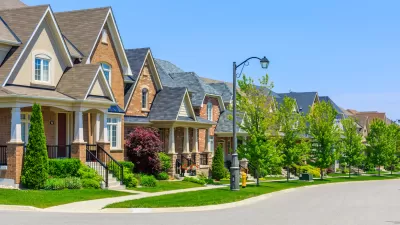A decades-old policy allowing hyperlocal zoning exemptions and restrictions creates a confusing patchwork of zoning regulations across the city.

A proposed overlay district in Philadelphia would ban roof decks and new construction taller than adjacent structures, prompting Jake Blumgart, writing in the Philadelphia Inquirer, to question the policy that allows City Council members to “create carve outs within the city’s overall zoning code to appease constituents, punish enemies, and implement hyperlocal priorities.”
Blumgart explains the history of zoning overlay districts, which operate within Philadelphia’s citywide zoning codes to “create a hyperlocal set of rules for a specific corner of the city, giving every City Council district its own idiosyncratic take on zoning rules.” The article describes several existing Philadelphia overlay districts, which in some cases exclude student housing or require extra steps for new business permits.
Critics say the complicated overlays discourage newcomers and entrepreneurs with lower access to capital. As Blumgart explains, “The rules are only navigable with a zoning attorney, and connections with local officials and neighborhood groups gives the advantage to monied, or politically connected, business owners.” However, overlay districts have also created opportunities for some council members to implement affordable housing requirements in their districts. “For politicians like the Council president, the overlays are a means to address fears of neighborhood change and fight back against aspects of the new zoning code he does not like.”
FULL STORY: What a ban on roof decks in a corner of North Philly says about the city’s zoning code

Alabama: Trump Terminates Settlements for Black Communities Harmed By Raw Sewage
Trump deemed the landmark civil rights agreement “illegal DEI and environmental justice policy.”

Planetizen Federal Action Tracker
A weekly monitor of how Trump’s orders and actions are impacting planners and planning in America.

The 120 Year Old Tiny Home Villages That Sheltered San Francisco’s Earthquake Refugees
More than a century ago, San Francisco mobilized to house thousands of residents displaced by the 1906 earthquake. Could their strategy offer a model for the present?

In Both Crashes and Crime, Public Transportation is Far Safer than Driving
Contrary to popular assumptions, public transportation has far lower crash and crime rates than automobile travel. For safer communities, improve and encourage transit travel.

Report: Zoning Reforms Should Complement Nashville’s Ambitious Transit Plan
Without reform, restrictive zoning codes will limit the impact of the city’s planned transit expansion and could exclude some of the residents who depend on transit the most.

Judge Orders Release of Frozen IRA, IIJA Funding
The decision is a victory for environmental groups who charged that freezing funds for critical infrastructure and disaster response programs caused “real and irreparable harm” to communities.
Urban Design for Planners 1: Software Tools
This six-course series explores essential urban design concepts using open source software and equips planners with the tools they need to participate fully in the urban design process.
Planning for Universal Design
Learn the tools for implementing Universal Design in planning regulations.
Clanton & Associates, Inc.
Jessamine County Fiscal Court
Institute for Housing and Urban Development Studies (IHS)
City of Grandview
Harvard GSD Executive Education
Toledo-Lucas County Plan Commissions
Salt Lake City
NYU Wagner Graduate School of Public Service





























